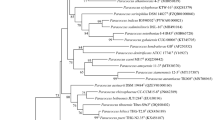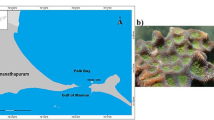Abstract
Two novel Gram-negative bacterial strains BT190T and BT191 were isolated from soil collected in Uijeongbu city (37°44′55″N, 127°02′20″E), Korea. Phylogenetic analysis based on 16S rRNA gene sequences revealed that strains BT190T and BT191 belong to a distinct lineage within the genus Hymenobacter (family Hymenobacteraceae, order Cytophagales, class Cytophagia). The level of 16S rRNA gene sequence similarity between the strains BT190T and BT190 was 99.5%. The strains BT190T and BT191 were closely related to Hymenobacter swuensis DY53T (97.0% 16S rRNA gene similarity), Hymenobacter metallilatus 9PBR-2 T (96.8%), Hymenobacter tibetensis XTM003T (96.8%) and Hymenobacter yonginensis HMD1010T (96.6%). The genome size of strain BT190T was 4,859,864 bp. The DNA G+C content of strain BT190T was 55.3 mol%. Bacterial growth was observed at 4–30 °C (optimum 25 °C) and pH 6.0–9.0 (optimum, pH 6.0–7.0) on R2A agar. Colonies of strains BT190T and BT191 were raised, smooth, circular and red-pink colored. The sole respiratory quinone of strain BT190T was MK-7 and the predominant cellular fatty acids were iso-C15:0, C16:1 ω5c, summed feature 3 (C16:1 ω6c / C16:1 ω7c) and summed feature 4 (iso-C17:1 I / anteiso-C17:1 B). The major polar lipids of strain BT190T were aminophospholipid (APL) and phosphatidylethanolamine (PE). Based on the chemotaxonomic, biochemical, and phylogenetic analysis, strains BT190T and BT191 can be suggested as a novel bacterial species within the genus Hymenobacter, for which the name Hymenobacter puniceus sp. nov is proposed. The type strain of Hymenobacter puniceus is BT190T (= KCTC 72342 T = NBRC 114860 T).


Similar content being viewed by others
References
Camacho C, Coulouris G, Avagyan V, Ma N, Papadopoulos J, Bealer K, Madden TL (2009) BLAST+: architecture and applications. BMC Bioinformatics 10:421
Cappuccino JG, Sherman N (2002) Microbiology- A laboratory manual, 6th edn. Pearson Education, Inc., Benjamin Cummings, California
Chung AP, Lopes A, Nobre MF et al (2010) Hymenobacter perfusus sp. nov., Hymenobacter flocculans sp. nov. and Hymenobacter metalli sp. nov. three new species isolated from an uranium mine waste water treatment system. Syst Appl Microbiol 33:436–443. https://doi.org/10.1016/j.syapm.2010.09.002
Cox MM, Battista JR (2005) Deinococcus radiodurans - the consummate survivor. Nat Rev Microbiol 3:882–892
Dai J, Wang Y, Zang L, Tang Y, Luo X, An H, Fang C (2009) Hymenobacter tibetensis sp. nov., a UV-resistant bacterium isolated from Qinghai-Tibet plateau. Syst Appl Microbiol 32:543–548. https://doi.org/10.1016/j.syapm.2009.09.001
Felsenstein J (1985) Confidence limit on phylogenies: an approach using the bootstrap. Evolution 39:783–791
Feng GD, Zhang J, Zhang XJ, Wang SN, Xiong X, Zhang YL, Huang HR, Zhu HH (2019) Hymenobacter metallilatus sp. nov., isolated from abandoned lead–zinc ore. Int J Syst Evol Microbiol 69:2142–2146. https://doi.org/10.1099/ijsem.0.003450
Feng GD, Zhang J, Chen W, Wang SN, Zhu H (2020) Hymenobacter fodinae sp. nov. and Hymenobacter metallicola sp. nov., isolated from abandoned lead-zinc mine. Int J Syst Evol Microbiol 70:4867–4873
Han L, Wu SJ, Qin CY et al (2014) Hymenobacter qilianensis sp. nov., isolated from a subsurface sandstone sediment in the permafrost region of Qilian Mountains, China and emended description of the genus Hymenobacter. Antonie Van Leeuwenhoek 105:971–978. https://doi.org/10.1007/s10482-014-0155-y
Hiraishi A, Ueda Y, Ishihara J, Mori T (1996) Comparative lipoquinone analysis of influent sewage and activated sludge by high performance liquid chromatography and photodiode array detection. J Gen Appl Microbiol 42:457–469
Hirsch P, Ludwig W, Hethke C, Sittig M, Hoffmann B, Gallikowski CA (1998) Hymenobacter roseosalivarius gen. nov., sp. nov., from continental Antarctic soils and sandstone: bacteria of the cytophaga/flavobacterium/bacteriodes line of phylogenetic descent. Syst Appl Microbiol 21:374–383. https://doi.org/10.1016/S0723-2020(98)80047-7
Im S, Song D, Joe M, Kim D, Park DH, Lim S (2013) Comparative survival analysis of 12 histidine kinase mutants of Deinococcus radiodurans after exposure to DNA-damaging agents. Bioprocess Biosyst Eng 36:781–789. https://doi.org/10.1007/s00449-013-0904-8
Joung Y, Cho SH, Kim H, Kim SB, Joh K (2011) Hymenobacter yonginensis sp. nov., isolated from mesotrophic artificial lake. Int J Syst Evol Microbiol 61:1511–1514. https://doi.org/10.1099/ijs.0.024588-0
Kang H, Cha I, Kim H, Joh K (2018) Hymenobacter aquatilis sp. Nov., isolated from a mesotrophic artificial lake. Int J Syst Evol Microbiol 68(6):2036–2041. https://doi.org/10.1099/ijsem.0.002792
Kim MK, Kang M-S, Srinivasan S et al (2017) Complete genome sequence of Hymenobacter sedentarius DG5BT, a bacterium resistant to gamma radiation. Mol Cell Toxicol 13:199–205. https://doi.org/10.1007/s13273-017-0021-x
Kimura M (1983) The neutral theory of molecular evolution. Cambridge University Press, Cambridge
Komagata K, Suzuki K (1987) 4 Lipid and cell-wall analysis in bacterial systematics. Method Microbiol 19:161–207
Konstantinidis KT, Tiedje JM (2005) Genomic insights that advance the species definition for prokaryotes. Proc Natl Acad Sci USA 102:2567–2572
Kumar S, Stecher G, Li M, Knyaz C, Tamura K (2018) MEGA x: molecular evolutionary genetics analysis across computing platforms. Mol Biol Evol 35(6):1547–1549. https://doi.org/10.1093/molbev/msy096
Lee JJ, Srinivasan S, Lim S, Joe M, Lee SH, Kwon AS, Kwon YJ, Lee J, Choi JJ, Lee HM, Auh YK, Kim MK (2014) Hymenobacter swuensis sp. nov., a gamma-radiation-resistant bacteria Isolated from mountain soil. Curr Microbiol 68:305–310. https://doi.org/10.1007/s00284-013-0478-3
Lee JJ, Lee YH, Park SJ, Lee SY, Park S, Kim MK, Ten LN, Jung HY (2017) Hymenobacter seoulensis sp. nov., isolated from river water. Int J Syst Evol Microbiol 67:596–601
Liang Y, Tang K, Wang Y, Yuan B, Tan F, Feng F, Liu H (2019) Hymenobacter crusticola sp. nov., isolated from biological soil crust. Int J Syst Evol Microbiol 69:547–551
Meier-Kolthof JP, Klenk H-P, Göker M (2014) Taxonomic use of DNA G+C content and DNA-DNA hybridization in the genomic age. Int J Syst Evol Microbiol 64:352–356. https://doi.org/10.1099/ijs.0.056994-0
Meier-Kolthoff JP, Auch AF, Klenk HP, Göker M (2013) Genome sequence-based species delimitation with confidence intervals and improved distance functions. BMC Bioinformatics 14:60
Minnikin DE, O’Donnell AG, Goodfellow M, Alderson G, Athalye M, Schaal A, Parlett JH (1984) An integrated procedure for the extraction of bacterial isoprenoid quinones and polar lipids. J Microbiol Meth 2:233–241
Munoz R, Rossello MR, Amann R (2017) Revised phylogeny of Bacteroidetes and proposal of sixteen new taxa and two new combinations including Rhodothermaeota phyl. nov. Syst Appl Microbiol 39:281–296. https://doi.org/10.1016/j.syapm.2016.04.004
Na SI, Kim YO, Yoon SH, Ha SM, Baek I, Chun J (2018) UBCG: Up-to-date bacterial core gene set and pipeline for phylogenomic tree reconstruction. J Microbiol 56:280–285
Saitou N, Nei M (1987) The neighbor-joining method: a new method for reconstructing phylogenetic trees. Mol Bio Evol 4:406–425
Sasser M (1990) Identification of Bacteria by Gas Chromatography of Cellular Fatty Acids. MIDI Technical Note 101. Newark, DE: MIDI Inc
Sedláček I, Pantůček R, Králová S, Mašlaňová I, Holochová P, Staňková E, Vrbovská V, Švec P, Busse HJ (2019) Hymenobacter amundsenii sp. nov. resistant to ultraviolet radiation, isolated from regoliths in Antarctica. Syst Appl Microbiol 42:284–290
Sedláček I, Pantůček R, Zeman M, Holochová P, Šedo O, Staňková E, Švec P, Králová S, Vídeňská P, Micenková L, Urvashi KS, Lal R (2020) Hymenobacter terrestris sp. nov. and Hymenobacter lapidiphilus sp. nov., isolated from regoliths in Antarctica. Int J Syst Evol Microbiol 70:6364–6372
Selvam K, Duncan JR, Tanaka M, Battista JR (2013) DdrA, DdrD, and PprA: Components of UV and Mitomycin C Resistance in Deinococcus radiodurans R1. PLoS ONE 8(7):e69007. https://doi.org/10.1371/journal.pone.0069007
Tatusova T, DiCuccio M, Badretdin A et al (2016) NCBI prokaryotic genome annotation pipeline. Nucleic Acids Res 44:6614–6624. https://doi.org/10.1093/nar/gkw569
Weisburg WG, Barns SM, Pellerier DA, Lane DJ (1991) 16S ribosomal DNA amplification for phylogenetic study. J Bacteriol 173:697–703
Yang Z (1995) Phylogenetie analysis using parsimony and likelihood methods. J Mol Evol 1996(42):294–307
Yu SL, Lee SK (2017) Ultraviolet radiation: DNA damage, repair, and human disorders. Mol Cell Toxicol 13:21–28
Zhang L, Dai J, Tang Y et al (2009) Hymenobacter deserti sp. nov., isolated from the desert of Xinjiang, China. Int J Syst Evol Microbiol 59:77–82. https://doi.org/10.1099/ijs.0.000265-0
Acknowledgements
We are grateful to Prof. Aharon Oren (The Hebrew University of Jerusalem, Israel) for helping with the etymology.
Funding
This work was supported by a research grant from Seoul Women’s University (2021) and by a grant from the National Institute of Biological Resources (NIBR), funded by the Ministry of Environment of the Republic of Korea (NIBR202002108).
Author information
Authors and Affiliations
Contributions
All authors equally contributed to this work.
Corresponding authors
Ethics declarations
Conflict of interests
The authors declare that there are no conflict of interests.
Ethical approval
This article does not contain any studies with human participants or animals.
Additional information
Publisher's Note
Springer Nature remains neutral with regard to jurisdictional claims in published maps and institutional affiliations.
The 16S rRNA gene sequence of the strain BT190T was deposited in GenBank/EMBL/DDBJ under the accession numbers are MN795741. The draft genome sequence of the strain BT190T is available at the following accession JACSCX000000000.
Supplementary Information
Below is the link to the electronic supplementary material.
10482_2021_1630_MOESM1_ESM.docx
Supplementary file 1 Fig. S1. Transmission electron micrograph of strains BT190T (a) and BT191 (b) from cultures grown on R2A agar for 3 days at 25 °C. Bars are 500 nm (DOCX 568 KB)
10482_2021_1630_MOESM2_ESM.docx
Supplementary file 2 Fig. S2. Genome-based phylogenetic tree reconstructed using a set of 92 UBCGs. The numbers at the nodes indicate the gene support index (maximal value is 92). Bar, 0.02 substitutions per position (DOCX 57 KB)
10482_2021_1630_MOESM3_ESM.docx
Supplementary file 3 Fig. S3. Polar lipid profile of strain BT190T after two-dimensional chromatography. (a) total lipids; (b) phospholipids; (c) aminolipids; (d) glycolipids. Abbreviations: PL, phospholipid; APL, aminophospholipid; PE, phosphatidylethanolamine; GL, glycolipid; L, lipid (DOCX 1167 KB)
Rights and permissions
About this article
Cite this article
Park, Y., Maeng, S., Damdintogtokh, T. et al. Hymenobacter puniceus sp. nov., radiation resistant bacteria isolated from soil in South Korea. Antonie van Leeuwenhoek 114, 1647–1655 (2021). https://doi.org/10.1007/s10482-021-01630-7
Received:
Accepted:
Published:
Issue Date:
DOI: https://doi.org/10.1007/s10482-021-01630-7




